How to Analyze Models of Nonlinear Public Goods
Abstract
:1. Introduction
1.1. Public Goods
1.2. Multiplayer Games and Nonlinear Benefits
1.3. Rationale of the Paper
2. How to Analyze Nonlinear Public Goods Games
2.1. The Replicator Dynamics with Two Strategies
2.2. Nonlinear Benefits
2.3. Bernstein Polynomials
- The Bernstein polynomial basis of degree n on x in [0, 1] is defined, for i = 0, …, n, by
- A polynomial in Bernstein form of degree n associated with any continuous function fi on [0, 1] is defined for each positive integer n as
- fi is called the Bernstein coefficient
- End-point values: The initial and final values of f and F are the same: F(0) = f0; F(1) = fn.
- Shape preservation: F and f have the same shape (monotonicity, convexity, concavity).
- Variation-diminishing property: The number Z of real roots of F in (0,1)is less than the number S of sign changes of f by an even amount: Z = S − 2j for some integer j greater or equal to 0 and lower than the integer part of n/2 [53] (each root contributes according to its multiplicity).
2.4. Characterizing the Dynamics
- If c ≥ (the maximum value of ) there is a unique stable equilibrium x = 0 (producers go extinct) (c1 in Figure 3)
- If Max[Δb0, Δbn−1] ≤ c < there are two stable equilibria: a pure equilibrium x = 0 made of all non-producers and a mixed equilibrium x*; the basins of attraction of these two equilibria are separated by a mixed unstable equilibrium x^; if the initial frequency of producers x < x^ the population will evolve to x = 0; if x > x^ it will evolve to x* (c2 in Figure 3).
- If Δb0 ≤ c < Δbn−1 (this case can exist only for h > 0.5) there is a unique interior unstable equilibrium x^ separating the basins of attraction of two pure stable equilibria: x = 0 and x = 1; if x < x^ the population will evolve to x = 0; if x > x^ it will evolve to x = 1 (c3 in Figure 3).
- If Δbn−1 ≤ c < Δb0 (this case can exist only for h < 0.5) there is a unique interior stable equilibrium x*, to which the population will converge irrespective of the initial frequencies of the two types (c3 in Figure 3).
- If c < Min[Δb0, Δbn−1] there is a unique stable equilibrium x = 1 (non-producers will go extinct) (c4 in Figure 3).
2.5. Comparison with Pairwise and Linear Games
2.6. Finding the Equilibria
2.7. Goodness of the Approximation
2.8. Approaches to Calculate the Equilibria
- Using the exact formula from (8), by setting (x) = 0. This is a reasonable approach for n not too large (the “Reduce” command in Mathematica 11, on a laptop with a 2.9 GHz processor and 16 GB of memory, enables this for n up to about 50) but the results become inaccurate as n grows and it is hopeless for very large n, when numerical methods become necessary.
- The equilibrium can also be approximated by setting Δb = 0, but similar computational problems arise.
- Using the Bernstein approximation outlined above, the equilibrium can be easily calculated for any n from Equations (21)–(24). The accuracy of this approach, as we have seen (Figure 6), improves with n and declines with s.
- For large n and large s, an alternative method is to find the equilibria of a Heaviside step function with the same inflection h using the following equation (25) (where k = hn):
2.9. More Than Two Strategies
3. Conclusions
Acknowledgments
Conflicts of Interest
References
- Hardin, J. The tragedy of the commons. Science 1968, 162, 1243–1248. [Google Scholar] [CrossRef] [PubMed]
- Burt, A.; Trivers, R. Genes in Conflict; Harvard University Press: Cambridge, MA, USA, 2006. [Google Scholar]
- West, S.A.; Diggle, S.P.; Buckling, A.; Gardner, A.; Griffin, A.S. The social lives of microbes. Annu. Rev. Ecol. Evol. Syst. 2007, 38, 53–77. [Google Scholar] [CrossRef]
- Jouanneau, J.; Moens, G.; Bourgeois, Y.; Poupon, M.F.; Thiery, J.P. A minority of carcinoma cells producing acidic fibroblast growth factor induces a community effect for tumor progression. Proc. Nat. Acad. Sci. USA 1994, 91, 286–290. [Google Scholar] [CrossRef] [PubMed]
- Axelrod, R.; Axelrod, D.E.; Pienta, K.J. Evolution of cooperation among tumor cells. Proc. Nat. Acad. Sci. USA 2006, 103, 13474–13479. [Google Scholar] [CrossRef] [PubMed]
- Packer, C.; Scheel, D.; Pusey, A.E. Why lions form groups, food is not enough. Am. Nat. 1990, 136, 1–19. [Google Scholar] [CrossRef]
- Maynard Smith, J.; Szathmáry, E. The Major Transitions in Evolution; Freeman: San Francisco, CA, USA, 1995. [Google Scholar]
- Tucker, A. A two-person dilemma (1950). In Readings in Games and Information; Rasmusen, E., Ed.; Blackwell: Oxford, UK, 2001; pp. 7–8. [Google Scholar]
- Rapoport, A.; Chammah, A.M. The game of chicken. Am. Behav. Sci. 1966, 10, 10–28. [Google Scholar] [CrossRef]
- Maynard Smith, J.; Price, G.R. The logic of animal conflict. Nature 1973, 246, 15–18. [Google Scholar] [CrossRef]
- Sugden, R. The Economics of Rights, Cooperation and Welfare; Blackwell: Oxford, UK, 1986. [Google Scholar]
- Hamburger, H. N-person Prisoners Dilemma. J. Math. Sociol. 1973, 3, 27–48. [Google Scholar] [CrossRef]
- Fox, J.; Guyer, M. Public Choice and cooperation in N-person Prisoner’s Dilemma. J. Confl. Resolut. 1978, 22, 469–481. [Google Scholar] [CrossRef]
- Rankin, D.J.; Bargum, K.; Kokko, H. The tragedy of the commons in evolutionary biology. Trends Ecol. Evol. 2007, 12, 643–651. [Google Scholar] [CrossRef] [PubMed] [Green Version]
- Kollock, P. Social dilemmas, the anatomy of cooperation. Ann. Rev. Sociol. 1998, 24, 183–214. [Google Scholar] [CrossRef]
- Cornish-Bowden, A. Fundamentals of Enzyme Kinetics, 4th ed.; Wiley Blackwell: Hoboken, NJ, USA, 2012. [Google Scholar]
- Frank, S.A. Input-output relations in biological systems, measurement, information and the Hill equation. Biol. Dir. 2013, 8, 31. [Google Scholar] [CrossRef] [PubMed]
- Archetti, M.; Scheuring, I. Evolution of optimal Hill coefficients in nonlinear public goods games. J. Theor. Biol. 2016, 406, 73–82. [Google Scholar] [CrossRef] [PubMed] [Green Version]
- Tomlinson, I.P. Game-theory models of interactions between tumour cells. Eur. J. Cancer 1997, 33, 1495–1500. [Google Scholar] [CrossRef]
- Tomlinson, I.P.; Bodmer, W.F. Modelling consequences of interactions between tumour cells. Br. J. Cancer 1997, 75, 157–160. [Google Scholar] [CrossRef] [PubMed]
- Bach, L.A.; Bentzen, S.; Alsner, J.; Christiansen, F.B. An evolutionary-game model of tumour cell interactions, possible relevance to gene therapy. Eur. J. Cancer 2001, 37, 2116–2120. [Google Scholar] [CrossRef]
- Bach, L.A.; Sumpter, D.J.T.; Alsner, J.; Loeschke, V. Spatial evolutionary games of interaction among generic cancer cells. J. Theor. Med. 2003, 5, 47–58. [Google Scholar] [CrossRef]
- Basanta, D.; Hatzikirou, H.; Deutsch, A. Studying the emergence of invasiveness in tumours using game theory. Eur. Phys. J. 2008, 63, 393–397. [Google Scholar] [CrossRef]
- Basanta, D.; Simon, M.; Hatzikirou, H.; Deutsch, A. Evolutionary game theory elucidates the role of glycolysis in glioma progression and invasion. Cell Prolif. 2008, 41, 980–987. [Google Scholar] [CrossRef] [PubMed]
- Basanta, D.; Scott, J.G.; Rockne, R.; Swanson, K.R.; Anderson, A.R. The role of IDH1 mutated tumour cells in secondary glioblastomas, an evolutionary game theoretical view. Phys. Biol. 2011, 8, 015016. [Google Scholar] [CrossRef] [PubMed]
- Basanta, D.; Scott, J.G.; Fishman, M.N.; Ayala, G.; Hayward, S.W.; Anderson, A.R. Investigating prostate cancer tumour-stroma interactions, clinical and biological insights from an evolutionary game. Br. J. Cancer 2012, 106, 174–181. [Google Scholar] [CrossRef] [PubMed] [Green Version]
- Dingli, D.; Chalub, F.A.; Santos, F.C.; Pacheco, J. Cancer phenotype as the outcome of an evolutionary game between normal and malignant cells. Br. J. Cancer 2009, 101, 1130–1136. [Google Scholar] [CrossRef] [PubMed]
- Gerstung, M.; Nakhoul, H.; Beerenwinkel, N. Evolutionary games with affine fitness functions, applications to cancer. Dyn. Games Appl. 2011, 1, 370–385. [Google Scholar] [CrossRef]
- You, L.; Brown, J.S.; Thuijsman, F.; Cunningham, J.J.; Gatenby, R.A.; Zhang, J.S.; Stankova, K. Spatial vs. non-spatial eco-evolutionary dynamics in a tumor growth model. J. Theor. Biol. 2017, 435, 78–97. [Google Scholar] [CrossRef] [PubMed]
- Zhang, J.S.; Cunningham, J.J.; Brown, J.S.; Gatenby, R.A. Integrating evolutionary dynamics into treatment of metastatic castrate-resistant prostate cancer. Nat. Commun. 2017, 8, 1816. [Google Scholar] [CrossRef] [PubMed]
- Broom, M.; Cannings, C.; Vickers, G.T. Multiplayer matrix games. Bull. Math. Biol. 1997, 59, 931–952. [Google Scholar] [CrossRef] [PubMed]
- Archetti, M.; Scheuring, I. Review: Game theory of public goods in one-shot social dilemmas without assortment. J. Theor. Biol. 2012, 299, 9–20. [Google Scholar] [CrossRef] [PubMed]
- Archetti, M. The volunteer’s dilemma and the optimal size of a social group. J. Theor. Biol. 2009, 261, 475–480. [Google Scholar] [CrossRef] [PubMed]
- Archetti, M. Cooperation as a volunteer’s dilemma and the strategy of conflict in public goods games. J. Evol. Biol. 2009, 22, 2192–2200. [Google Scholar] [CrossRef] [PubMed]
- Archetti, M.; Scheuring, I. Coexistence of cooperation and defection in public goods games. Evolution 2011, 65, 1140–1148. [Google Scholar] [CrossRef] [PubMed]
- Boza, G.; Számadó, S. Beneficial laggards, multilevel selection, cooperative polymorphism and division of labour in threshold public good games. BMC Evol. Biol. 2010, 10, 336. [Google Scholar] [CrossRef] [PubMed]
- Archetti, M. Dynamics of growth factor production in monolayers of cancer cells. Evol. Appl. 2013, 6, 1146–1159. [Google Scholar] [CrossRef] [PubMed] [Green Version]
- Archetti, M. Evolutionarily stable anti-cancer therapies by autologous cell defection. Evol. Med. Public Health 2013, 1, 161–172. [Google Scholar] [CrossRef] [PubMed]
- Archetti, M. Evolutionary game theory of growth factor production, implications for tumor heterogeneity and resistance to therapies. Br. J. Cancer 2013, 109, 1056–1062. [Google Scholar] [CrossRef] [PubMed] [Green Version]
- Archetti, M. Evolutionary dynamics of the Warburg effect, glycolysis as a collective action problem among cancer cells. J. Theor. Biol. 2014, 341, 1–8. [Google Scholar] [CrossRef] [PubMed] [Green Version]
- Archetti, M. Stable heterogeneity for the production of diffusible factors in cell populations. PLoS ONE 2014, 9, e108526. [Google Scholar] [CrossRef] [PubMed] [Green Version]
- Archetti, M. Heterogeneity and proliferation of invasive cancer subclones in game theory models of the Warburg effect. Cell Prolif. 2015, 482, 259–269. [Google Scholar] [CrossRef] [PubMed] [Green Version]
- Archetti, M. Cooperation among cancer cells as public goods games on Voronoi networks. J. Theor. Biol. 2016, 396, 191–203. [Google Scholar] [CrossRef] [PubMed] [Green Version]
- Archetti, M.; Ferraro, D.A.; Christofori, G. Heterogeneity for IGF-II production maintained by public goods dynamics in neuroendocrine pancreatic cancer. Proc. Nat. Acad. Sci. USA 2015, 112, 1833–1838. [Google Scholar] [CrossRef] [PubMed] [Green Version]
- Kaznatcheev, A.; Velde, R.V.; Scott, J.G.; Basanta, D. Cancer treatment scheduling and dynamic heterogeneity in social dilemmas of tumour acidity and vasculature. Br. J. Cancer 2018, in press. [Google Scholar]
- Sartakhti, J.S.; Manshaei, M.H.; Bateni, S.; Archetti, M. Evolutionary dynamics of tumor-stroma interactions in multiple myeloma. PLoS ONE 2016, 1112, e0168856. [Google Scholar] [CrossRef] [PubMed]
- Hofbauer, J.; Sigmund, K. Evolutionary Games and Population Dynamics; Cambridge University Press: Cambridge, UK, 1998. [Google Scholar]
- Bernstein, S. Démonstration du théorème de Weierstrass fondée sur le calcul des probabilities. Comm. Soc. Math. Kharkov 1912, 13, 1–2. [Google Scholar]
- Farouki, R.T. The Bernstein polynomial basis, a centennial retrospective. Comput. Aided Geom. Des. 2012, 29, 379–419. [Google Scholar] [CrossRef]
- Lorentz, G.G. Bernstein Polynomials; University of Toronto Press: Toronto, ON, Canada, 1953. [Google Scholar]
- DeVore, R.A.; Lorentz, G.G. Constructive Approximation; Springer: Berlin, Germany, 1993. [Google Scholar]
- Phillips, G.M. Interpolation and Approximation by Polynomials; Springer: Berlin, Germany, 2003. [Google Scholar]
- Schoenberg, I.J. On variation diminishing approximation methods. In On Numerical Approximation; Langer, R.E., Ed.; University of Wisconsin Press: Madison, WI, USA, 1959. [Google Scholar]
- Motro, U. Cooperation and defection, playing the field and the ESS. J. Theor. Biol. 1991, 151, 145–154. [Google Scholar] [CrossRef]
- Pena, G.; Lehmann, L.; Noeldeke, G. Gains from switching and evolutionary stability in multi-player matrix games. J. Theor. Biol. 2014, 346, 23–33. [Google Scholar] [CrossRef] [PubMed] [Green Version]
- Voronovskaya, E. Détermination de la forme asymptotique d’ approximation des fonctions par les polynômes de M. Bernstein. CR Acad. Sci. URSS 1932, 79, 79–85. [Google Scholar]
- Mabry, R. Problem 10990. Am. Math. Mon. 2003, 110, 59. [Google Scholar] [CrossRef]
- Hamilton, W.D. The genetical evolution of social behaviour. J. Theor. Biol. 1964, 7, 1–52. [Google Scholar] [CrossRef]
- Frank, S.A. Foundations of Social Evolution; Princeton University Press: Princeton, NJ, USA, 1998. [Google Scholar]
- Nowak, M.A. Evolutionary Dynamics; Harvard University Press: Cambridge, MA, USA, 2006. [Google Scholar]
- Axelrod, R.; Hamilton, W.D. The Evolution of cooperation. Science 1981, 211, 1390–1396. [Google Scholar] [CrossRef] [PubMed]
- Greig, D.; Travisano, M. The Prisoner’s Dilemma and polymorphism in yeast SUC genes. Proc. R. Soc. Lond. Ser. B 2004, 27, S25–S26. [Google Scholar] [CrossRef] [PubMed]
- Gore, J.; Youk, H.; van Oudenaarden, A. Snowdrift game dynamics and facultative cheating in yeast. Nature 2009, 459, 253–256. [Google Scholar] [CrossRef] [PubMed]
- MacLean, R.C.; Fuentes-Hernandez, A.; Greig, D.; Hurst, L.D.; Gudelj, I. A Mixture of “Cheats” and “Co-Operators” Can Enable Maximal Group Benefit. PLoS Biol. 2010, 8, e1000486. [Google Scholar] [CrossRef] [PubMed]

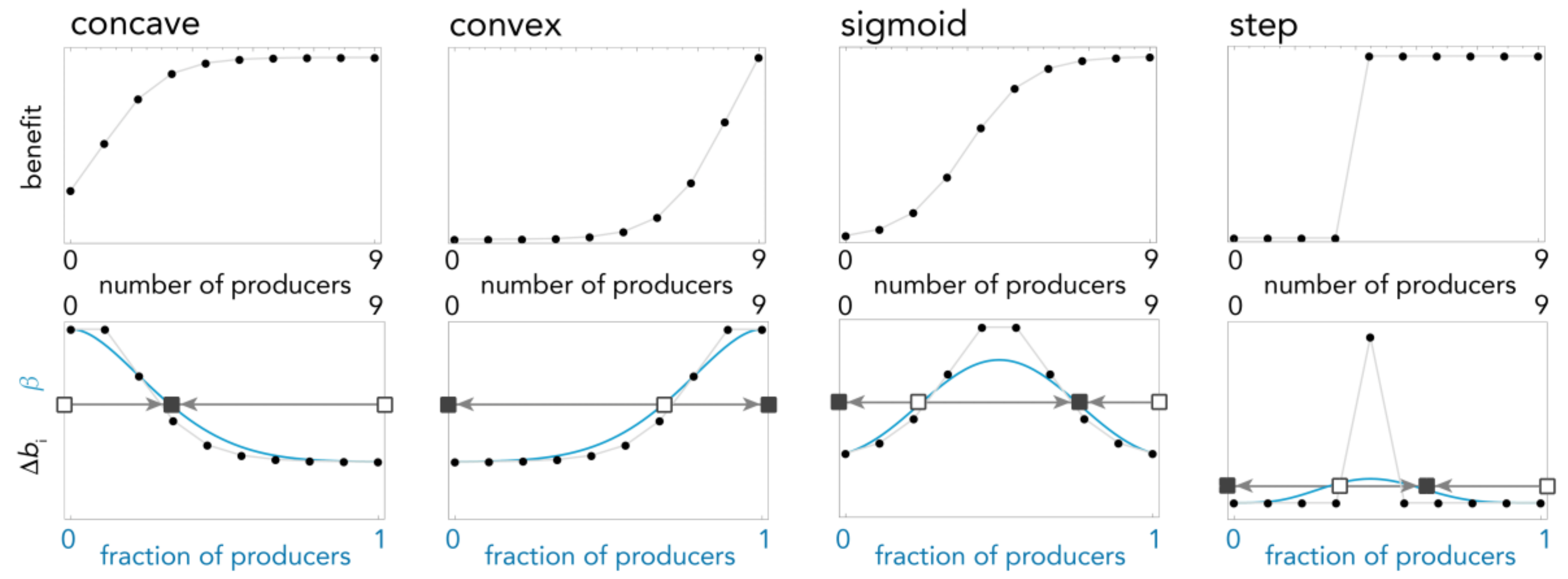
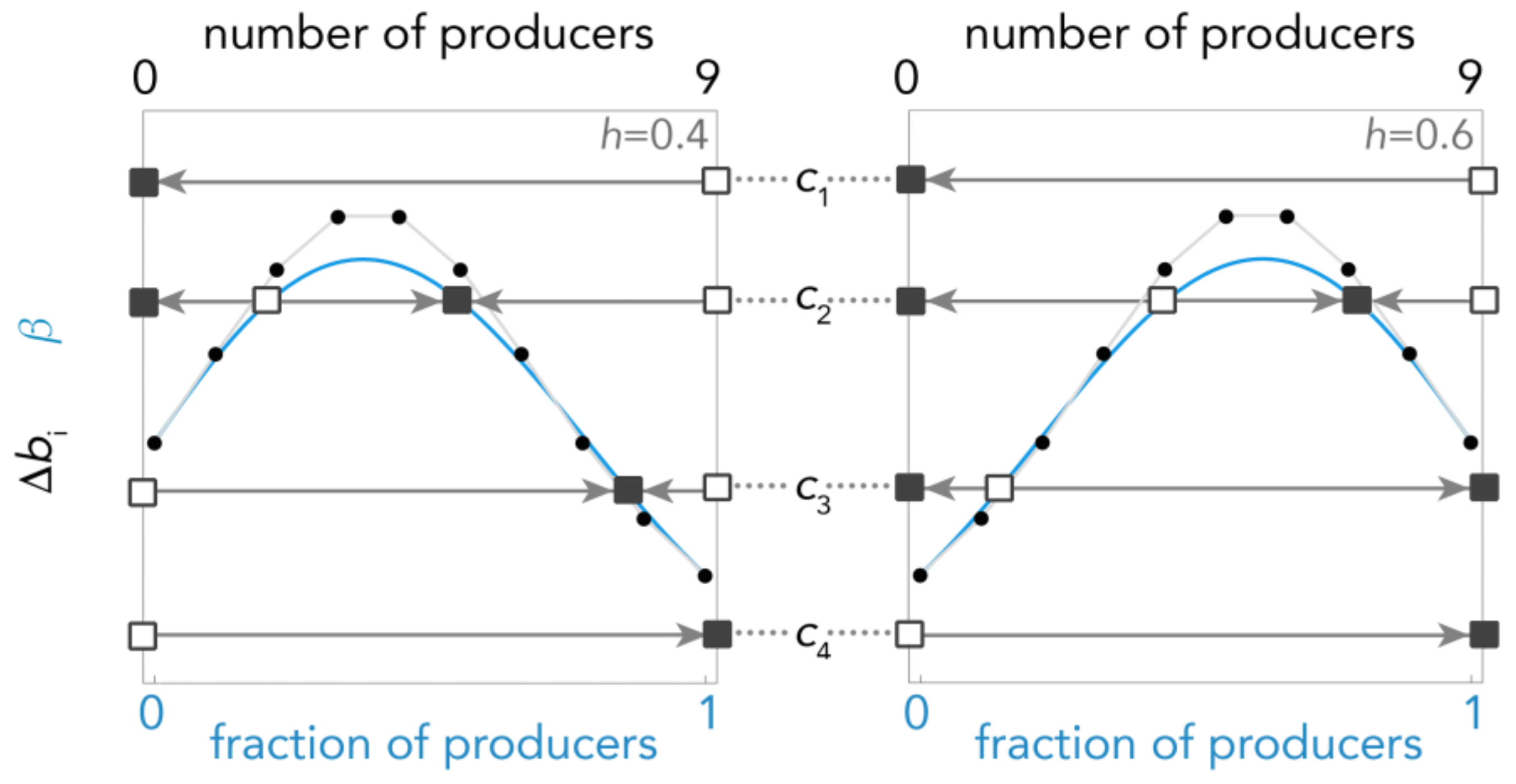
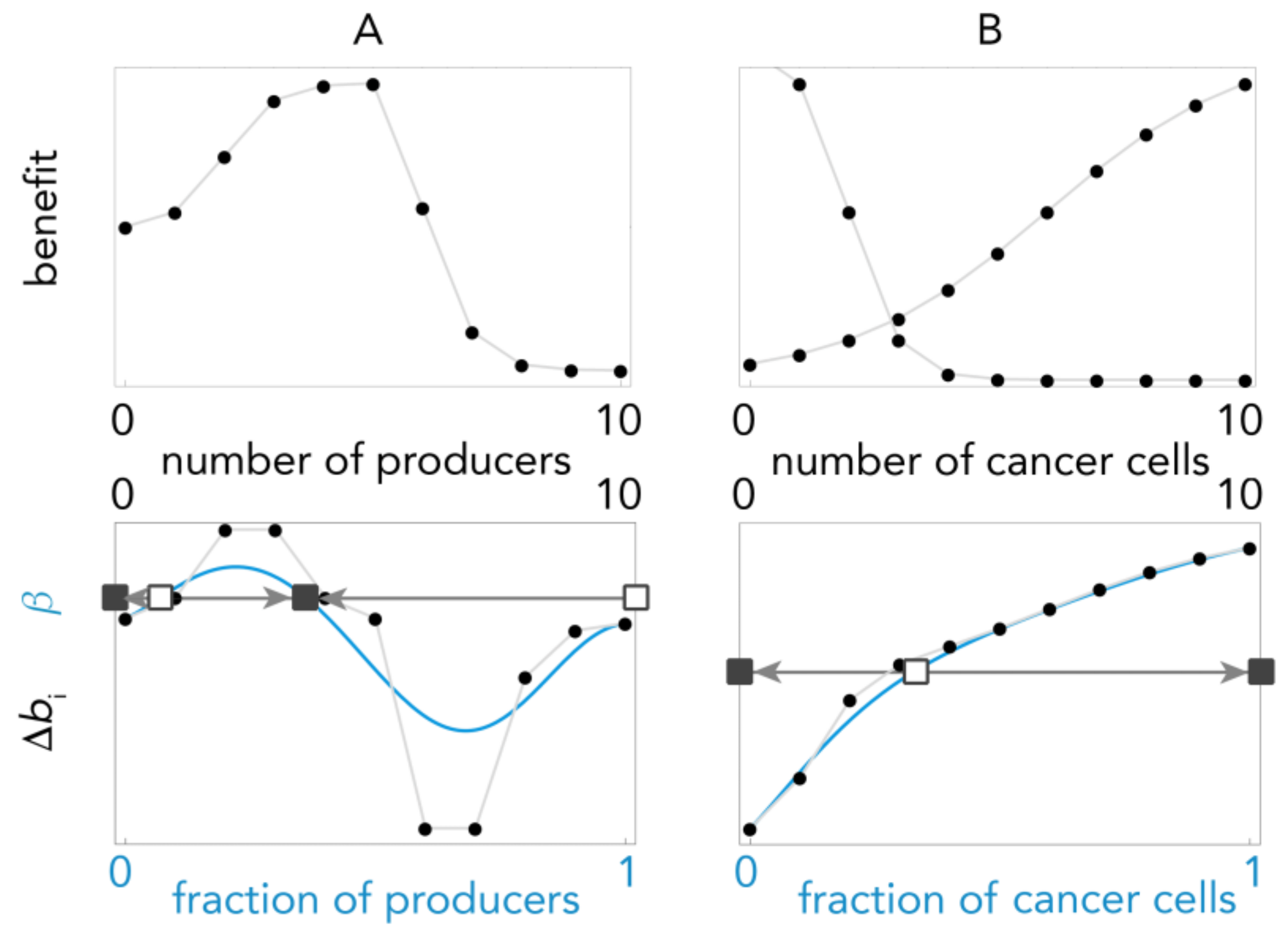
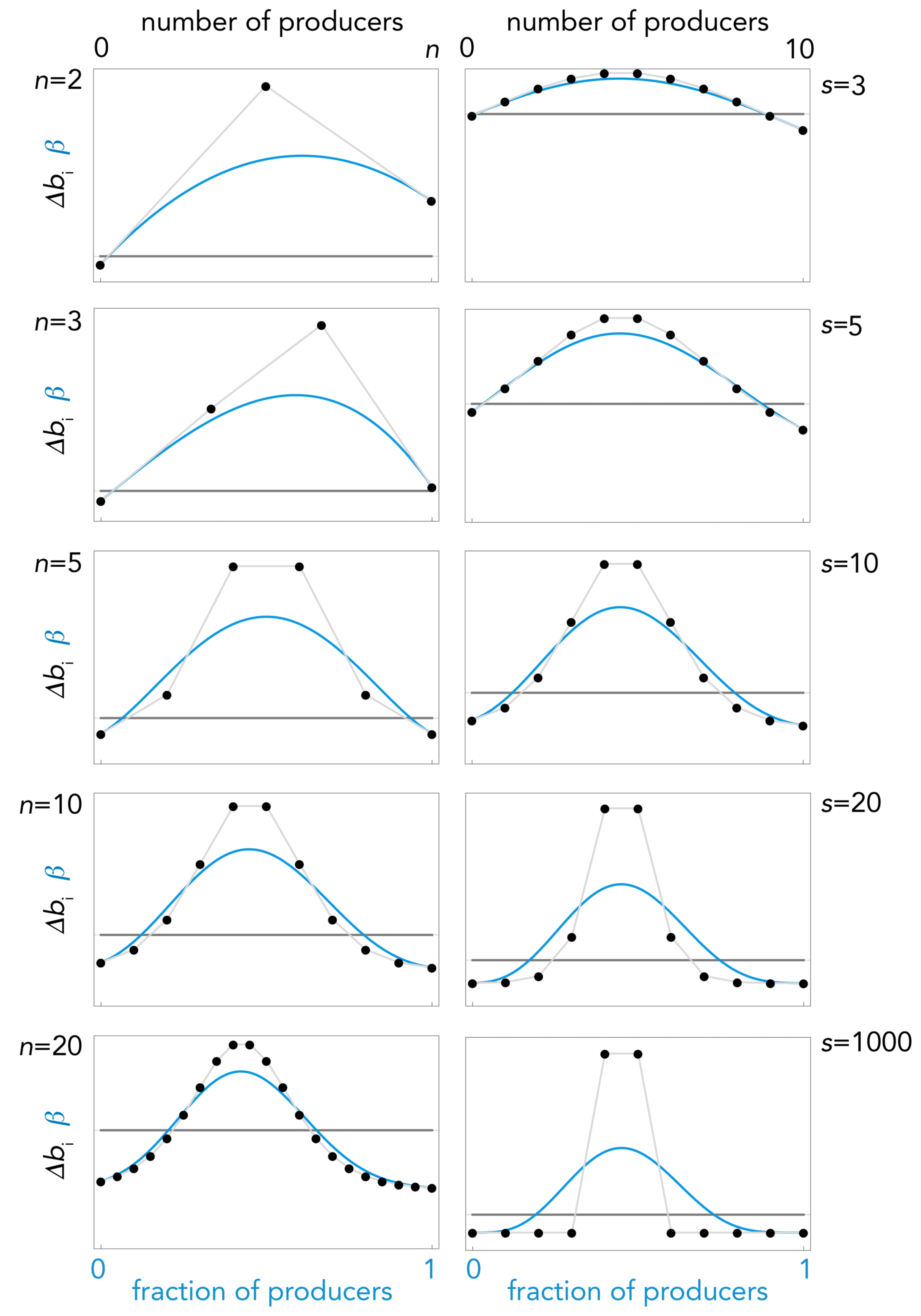
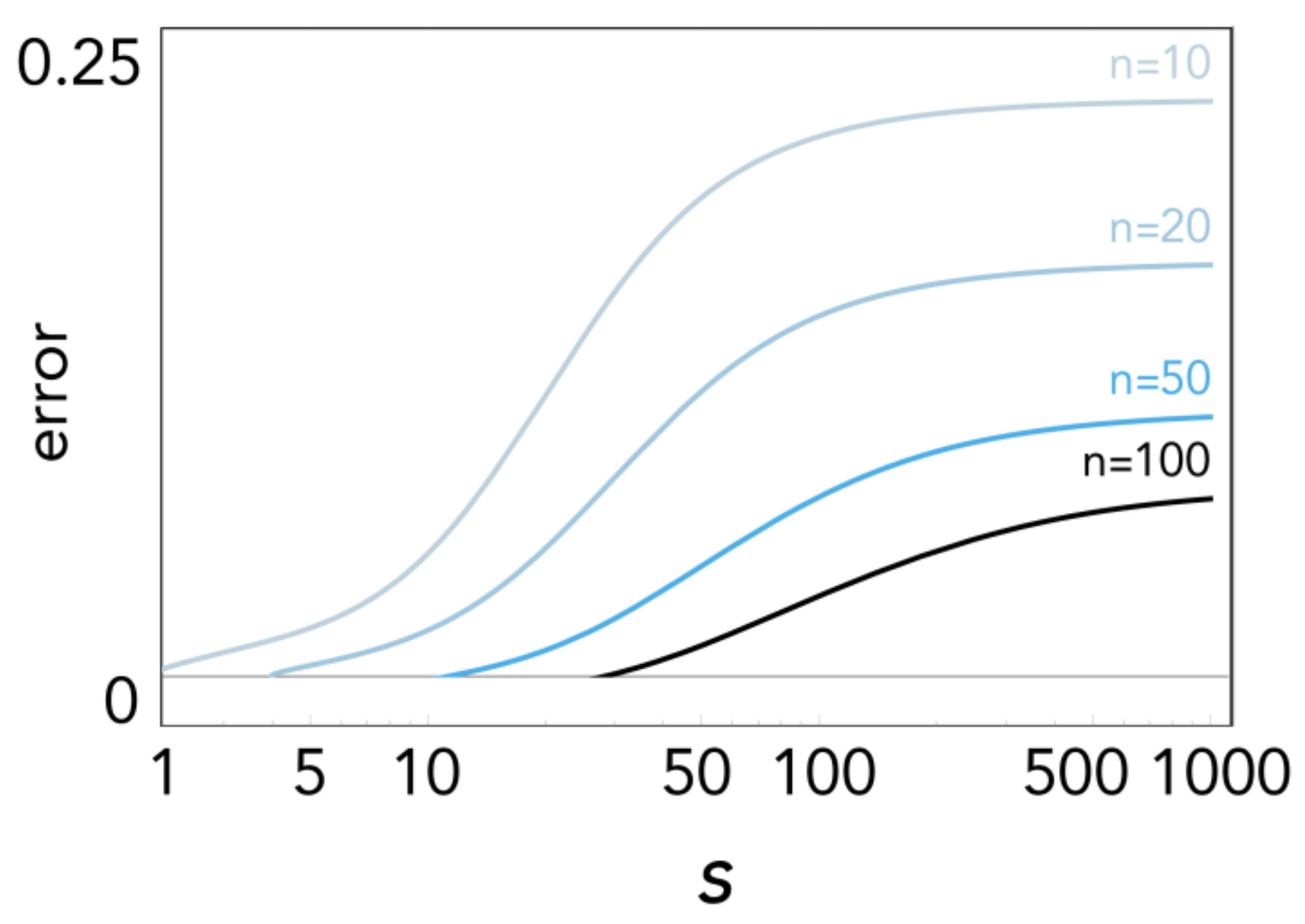


© 2018 by the authors. Licensee MDPI, Basel, Switzerland. This article is an open access article distributed under the terms and conditions of the Creative Commons Attribution (CC BY) license (http://creativecommons.org/licenses/by/4.0/).
Share and Cite
Archetti, M. How to Analyze Models of Nonlinear Public Goods. Games 2018, 9, 17. https://doi.org/10.3390/g9020017
Archetti M. How to Analyze Models of Nonlinear Public Goods. Games. 2018; 9(2):17. https://doi.org/10.3390/g9020017
Chicago/Turabian StyleArchetti, Marco. 2018. "How to Analyze Models of Nonlinear Public Goods" Games 9, no. 2: 17. https://doi.org/10.3390/g9020017




